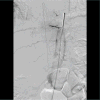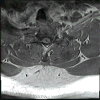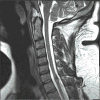A Review of Vascular Abnormalities of the Spine
- PMID: 28191502
- PMCID: PMC5300765
A Review of Vascular Abnormalities of the Spine
Abstract
Patients with spinal vascular lesions present with unique symptoms and have important anatomical and physiologic changes that must be considered prior to treatment. In this mini-review, we provide an overview of normal spinal vascular anatomy and discuss several key spinal vascular lesions. We provide an overview of cavernous malformations, intradural arteriovenous malformations, perimedullary arteriovenous fistulas, and dural arteriovenous fistulas. Important considerations are addressed in terms of pathologic characterization, specific imaging findings, and treatment approaches.
Keywords: Spine; Vascular lesions.
Figures








References
-
- Krings T. Vascular malformations of the spine and spinal cord*: anatomy, classification, treatment. Clin Neuroradiol. 2010;20:5–24. - PubMed
-
- See-Sebastian EH, Marks ER. Spinal cord intramedullary cavernoma: A case report. W V Med J. 2013;109:28–30. - PubMed
-
- Killeen T, Czaplinski A, Cesnulis E. Extradural spinal cavernous malformation: a rare but important mimic. Br J Neurosurg. 2014;28:340–346. - PubMed
-
- Kivelev J, Niemelä M, Hernesniemi J. Treatment strategies in cavernomas of the brain and spine. J Clin Neurosci. 2012;19:491–497. - PubMed
Grants and funding
LinkOut - more resources
Full Text Sources
